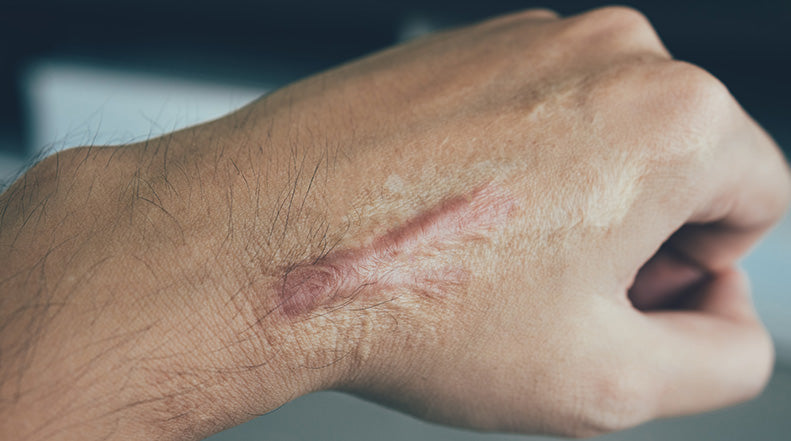How to Treat Keloid Scars

It is widely known that scars are the result of a healed injury to the skin, possibly from surgery, cuts, piercings, burns, chicken pox, or even acne. What most do not know is that there are several different types of scars. A keloid is an abnormally raised type of scar that is quite common. If you are someone who has a keloid scar, it is important to know that these can be reduced. Continue reading to find out how.
WHAT IS A KELOID SCAR?
A keloid is a prominent scar that will be noticeable due to its heaped up appearance on the skin. It may be lumpy, but is usually quite smooth and will have a red or purple hue to it. Its shape tends to be odd and irregular, but is not cause for worry as far as your health is concerned. It may also enlarge progressively. This means that the ultimate size of the scar will depend on the individual situation.
Keloids most often develop in people who are between the ages of ten to twenty years old, according to the National Institute of Health. They are most common in people of African, Asian, or Hispanic descent. They are rarely found on people with lightly colored skin. It has been theorized that keloids are somehow linked to the pigment that is in darker skin. However, this has not been proven.
Unlike other types of scarring, the tendency to develop keloids is passed genetically among family members. Half of people who reported having keloids in 2011 according to the Journal of Molecular Medicine, reported also having family members with such scarring.
WHAT CAUSES A KELOID SCAR?
Keloid scars are composed mainly of two types of collagen, protein molecules that play the key roles in the healing process when the skin is injured. It provides structural support for the wound. The typical control mechanisms regulating the development of the scar are absent in keloid formation. This type of scar forms when there is an overgrowth of early collagen, or type III. As the large amounts of type III collagen are being made, the body begins replacing it with late collagen, or type I. Type III collagen (early collagen), and type I collagen (late collagen), are the two types that play a role in the formation of a keloid scar.
SYMPTOMS OF A KELOID SCAR
You will be able to identify a keloid because of its firm, raised and almost shiny appearance on your skin. It can be extremely hard to catch these right in the beginning of their formation because you may think it is part of the normal healing process. As they grow larger and change in appearance they become easier to identify.
Keloid scars are, for the most part, not painful. However, they do tend to be extremely itchy. Most common places that they are found are on the arms, ears, lower legs, mid-chest, and neck. After the closure of your wound, the keloid may take years to develop and on occasion they have been found to continue to grow indefinitely.
COMPLICATIONS FROM KELOID SCARS
Generally speaking, there are very few complications that come along with the formation of a keloid scar. However, depending on their location, they tend to cause large amounts of psychological distress. They are both prominent and discolored, so they stand out and are usually very noticeable.
Keloids can also interfere with movement, but this will only occur if the scar is laying across a part of the body that bends, like a joint.
It is also important to note that keloids do not usually become cancerous. It is an extremely rare occurrence that cancer is the end result of such scarring. Regardless, it is best to have any keloid scar checked by a doctor regularly as they can be ever changing.
REDUCTION OPTIONS FOR KELOID SCARS
The larger the keloid, the more difficult it is to treat. If at all possible, catching this type of scar in its early stages is extremely important if you want to reduce the scar. Corticosteroid injections and laser are commonly used to shrink large keloids. Surgical revision of the scar is usually a last resort because keloids are very likely to reappear.
One way to help prevent or reduce the appearance of a keloid scar is to use silicone gel products. Newgel+ is a leading brand in scar reduction treatments and offers many options, both in sheeting and gel from a tube. Their products have proven results in the reduction of keloid scars. While you can begin treating your scar at any time, it will be most effective to begin as early as possible when it comes to keloid scars. If you are prone to forming keloids, begin treatment once any injury or incision is closed to help it heal normally.




Comments